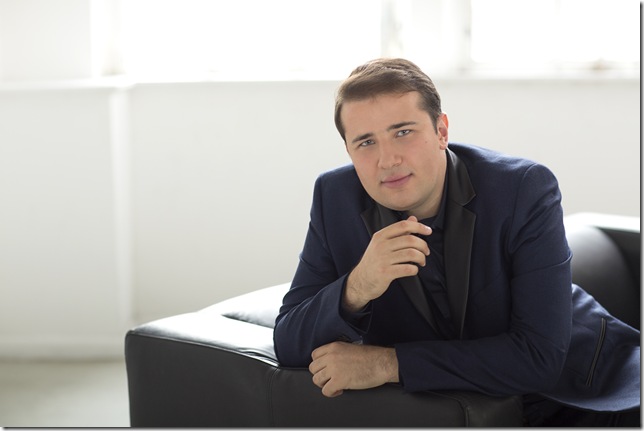Celebrating 25 years of music-making, the Atlantic Classical Orchestra, a fine, chamber-sized orchestra of 41 players, came to the Eissey Campus Theatre of Palm Beach Gardens State College from its Fort Pierce headquarters Tuesday to give the first of its four concerts scheduled there.
The orchestra’s stated mission is to broaden its outreach, and by using an all purpose name like “Atlantic,” it can do so with impunity; no one township claims complete ownership. It also plays the same concert in Vero Beach and Stuart. The famed Hallé Orchestra, established in Manchester, England, in 1858, has for many years given the same concert in Sheffield and Bradford, big cities with no orchestra 70 miles away in neighboring Yorkshire.
Under the competent baton of artistic director and conductor Stewart Robertson, the concert began with Mozart’s overture to his opera The Marriage of Figaro. Composed in 1786, it was to be the first flush of a five-year push in which Mozart wrote his last three great operas and other well known orchestral works before dying at 35 in 1791.
Robertson led a lovely, delicate rendering of the overture; after all, his familiarity with this work goes back to his years conducting opera in Miami and Cooperstown, N.Y. The orchestra, nicely positioned across the Eissey stage, was well balanced, as each section, clearly defined, caught one’s eye when they played their parts. All the wit and and cleverness of the opera are embedded in this work and the orchestra gave it a sparkling, fresh performance.
Putting aside the previously announced “Adagietto” from Mahler’s Fifth Symphony, the orchestra played instead a tribute to the fallen of the Charlie Hebdo atrocity in Paris with Samuel Barber’s haunting Adagio for Strings. Beautifully played by the string section only, this melancholy work gave the audience time for reflection.
Zoltan Kodaly’s Dances of Galanta followed. Composed in 1933, it is full of rich Hungarian folk music, rescued by the likes of the composer and his friend Bela Bartok. The dances, named for the township in which Kodaly spent his boyhood, begin with a strong cello statement answered by a solo horn. They repeat this and a solo clarinet then spells out the first of many folk tunes. The full orchestra plays this lovely folk melody as the cellos interject with more exciting sounds. A tripping new folk tune comes from the flute with the strings picking it up at a faster pace.
Kodaly spreads this tune around first with woodwinds, now the horn section and the trumpets, with the bassoons harrumphing a few bars in oppositional accompaniment. The full orchestra comes in with a very fast polka rhythm, another dance in which one imagines peasants and gypsies dancing around energetically.
Combining these folk melodies with classical harmonies makes for a big symphonic sound and the orchestra sounded wonderful at this moment. Audience approval for the pieces was raucous, with cries, shouts, applause and whistles in profusion.
Brahm’s Second Piano Concerto (in B-flat, Op. 83) came after the intermission, with pianist Stanislav Khristenko as soloist. Born in the Ukraine, he is a graduate of the Moscow State Tchaikovsky Music Conservatory, receiving his artist’s diploma from the Cleveland Institute of Music in 2010.
This is a massive work. At first, I admit to having reservations about whether this size orchestra could do it justice. Scored for piano, two flutes, two oboes, piccolo, two clarinets, two bassoons, four horns, two trumpets, timpani and strings, the Atlantic Orchestra had all these positions covered. What was missing, of course, was the broad sweep of a larger string section used in an orchestra of 70 or more players. This lack of string power was evident in the first movement but not so much in the last three.
The opening Allegro non troppo begins and ends with a horn call which is the seed of the first movement. Hornist Brian Blanchard was excellent throughout. The pianist made up for the missing strings with his forte playing, at times sounding louder than the orchestra accompanying him. In the heavily syncopated main exposition, I thought Khristenko’s playing pedantic in dealing with the difficult passages. He gets all the notes right but fails to get a singing, emotive tone behind his interpretation. Adjusting to the sensitivity of playing with a smaller orchestra, he took his foot off the loud pedal and began to soften his fingering. It is a beast to play, I must admit, and the pianists early adjustment signaled better things to come.
Beginning the scherzo confidently, Khristenko’s touch improved; there was more romance in his playing. The vast proportions of this movement were skillfully diminished and controlled by Robertson. Teamwork prevailed and the orchestral phrasing was excellent, the pianist’s interpretation breathtaking.
The beautiful solo playing of cellist Ashley Garritson opened the third movement. At the solo piano cadenza, the orchestra joined in with subtle pianissimo passages that made their coming together magical. The finale, marked Allegretto grazioso, is an unusual rondo based on three themes. A tippling tripping tune opens with difficult piano runs dominating the music. Khristenko’s upper keyboard passages and trills were excellent, and the rapid exchanges between pianist and the orchestra nicely accomplished.
Rather than end with a melodramatic grand statement, Brahms chooses lyricism over the familiar musical full stop of five or six thumping chords. As if from nowhere, piano and orchestra fall away into thin air leaving a long silence before a near riotous acclaim greeted the soloist, conductor and players. This was The Little Orchestra That Could. Robertson hugged the pianist and signaled the soloists to take a bow.
The Atlantic Classical Orchestra’s next performance is set for 3 p.m. Tuesday, Feb. 10, at the Eissey Campus Theatre, Palm Beach Gardens. The program includes music by Schubert, Richard Strauss (his First Horn Concerto, with soloist Brian Blanchard), Beethoven and a world premiere work by Patrick Harlin. For tickets or more information, call 772-460-0850 or visit www.atlanticclassicalorchestra.com.
